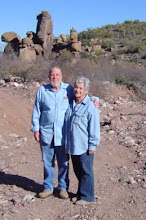1/18/07
Camp Reno was established by the 1st Cavalry in 1867 and abandoned in 1870. It was an outpost of Fort McDowell and was intended to establish a military presence in Tonto Basin and surrounding areas due to the problems settlers and ranchers were having with regular raids by the Apaches. The actual orders from General McDowell to the 1st Cavalry Captain simply stated,
"You will order that, in making these shelters, the commanding officer shall put them up in the order of time prescribed in General Orders No. 39, for the huts to be built at the camp to be established northeast from Fort McDowell, (Camp Reno). The same provisions as to extra pay to the enlisted men, therein made, will apply in the case of the new camp. I have not authorized more permanent quarters than those which the men could make by their own labor, with the materials at hand, because it was not known, nor could it be ascertained at once where permanent posts would be required. The population in this country is so fluctuating (on account of the uncertainty of mining operations), that it frequently happens that before a permanent post is finished the necessity for it has ceased."
Since the Camp was only operational for three years, one would assume that the "necessity for it had ceased" however, it is speculated that because of the remoteness of the camp, the high cost of supplying the camp was more likely the reason for its demise. The 1st Cavalry proved to be effective in curtailing the murderous raids during the three years they were encamped on a mesa at the foot of what is now Reno Pass.
Forest Service maps indicate Camp Reno being located at the foot of the mesa, but in actuality, that is not the correct location. The location marked by a sign is actually the location of Sutter's Store, a general store which was built by locals to supply the needs of the camp and surrounding settlers. Not much remains today of either Camp Reno or Sutter's Store. The area the store was in contains just a few concrete slabs and a spring. The remains of the camp are a bit harder to spot because they aren't marked but you can still see the stones in place outlining the places where the 1st Cavalry had their tents erected.
We hiked the area yesterday and found an old cemetery in the foothills. The entire area was severely damaged by wildfires a few years ago. Although there's not much to see, it's still fun to visit the area and speculate on what it must have been like.
"You will order that, in making these shelters, the commanding officer shall put them up in the order of time prescribed in General Orders No. 39, for the huts to be built at the camp to be established northeast from Fort McDowell, (Camp Reno). The same provisions as to extra pay to the enlisted men, therein made, will apply in the case of the new camp. I have not authorized more permanent quarters than those which the men could make by their own labor, with the materials at hand, because it was not known, nor could it be ascertained at once where permanent posts would be required. The population in this country is so fluctuating (on account of the uncertainty of mining operations), that it frequently happens that before a permanent post is finished the necessity for it has ceased."
Since the Camp was only operational for three years, one would assume that the "necessity for it had ceased" however, it is speculated that because of the remoteness of the camp, the high cost of supplying the camp was more likely the reason for its demise. The 1st Cavalry proved to be effective in curtailing the murderous raids during the three years they were encamped on a mesa at the foot of what is now Reno Pass.
Forest Service maps indicate Camp Reno being located at the foot of the mesa, but in actuality, that is not the correct location. The location marked by a sign is actually the location of Sutter's Store, a general store which was built by locals to supply the needs of the camp and surrounding settlers. Not much remains today of either Camp Reno or Sutter's Store. The area the store was in contains just a few concrete slabs and a spring. The remains of the camp are a bit harder to spot because they aren't marked but you can still see the stones in place outlining the places where the 1st Cavalry had their tents erected.
We hiked the area yesterday and found an old cemetery in the foothills. The entire area was severely damaged by wildfires a few years ago. Although there's not much to see, it's still fun to visit the area and speculate on what it must have been like.
Cemetery near Camp Reno


This wall was probably used to protect against Apache attacks

In actuality, this is not Camp Reno but instead is the site of Sutter's General Store

The spring at Sutter's Store

This wall was probably used to protect against Apache attacks
In actuality, this is not Camp Reno but instead is the site of Sutter's General Store
The spring at Sutter's Store
